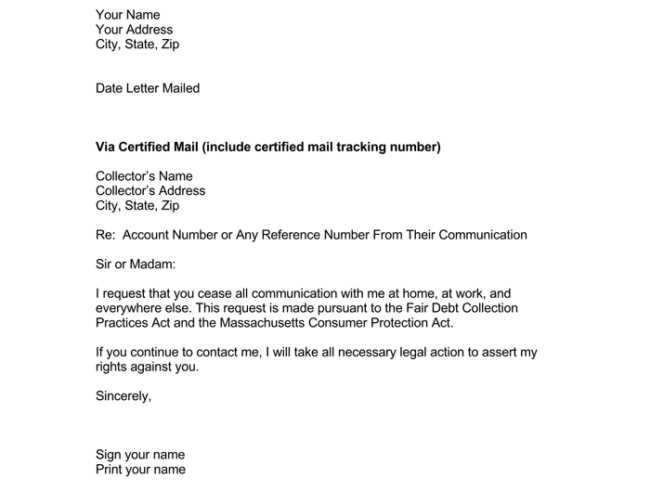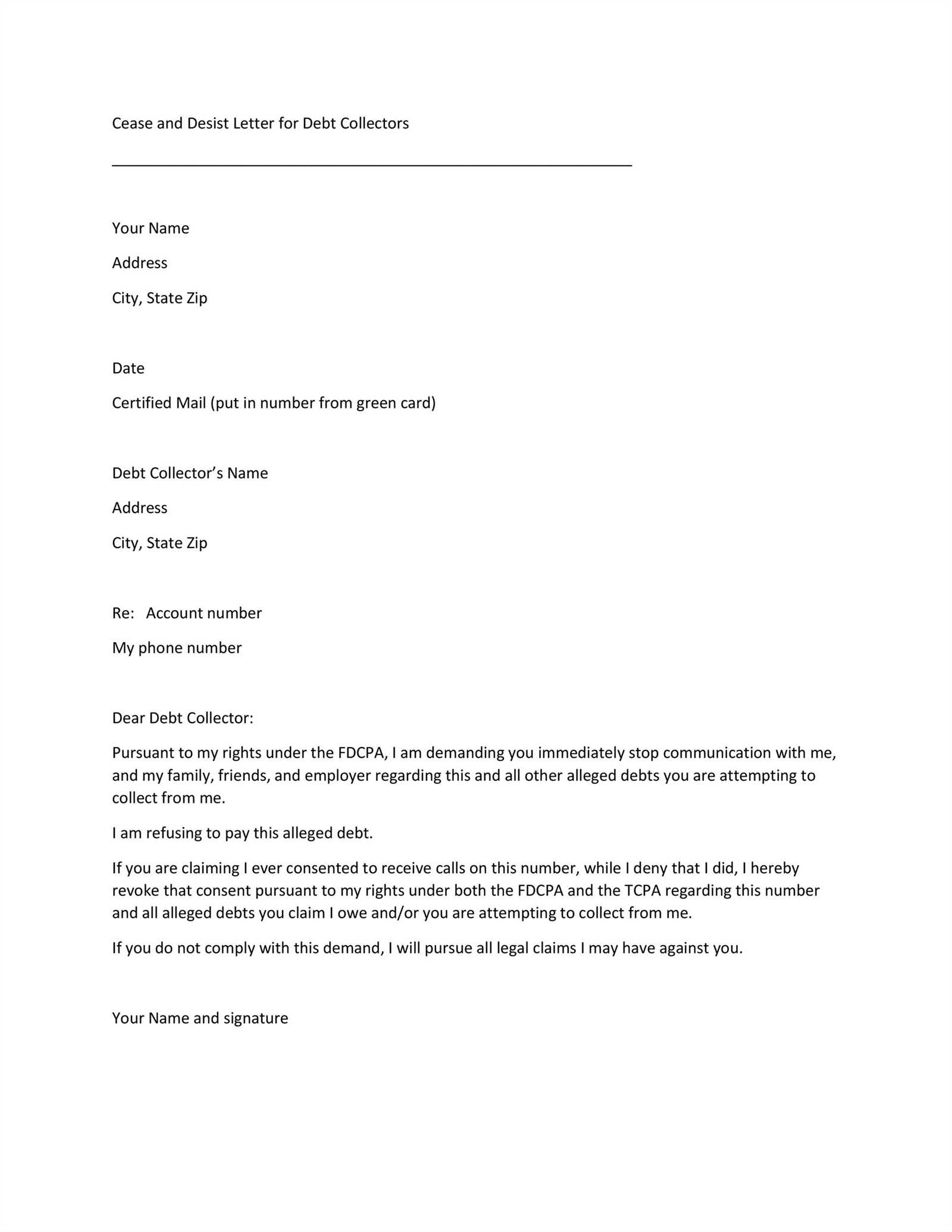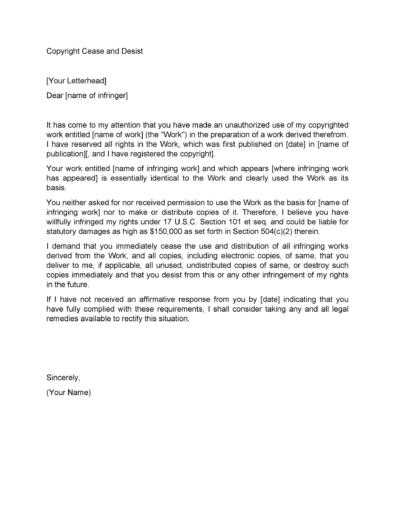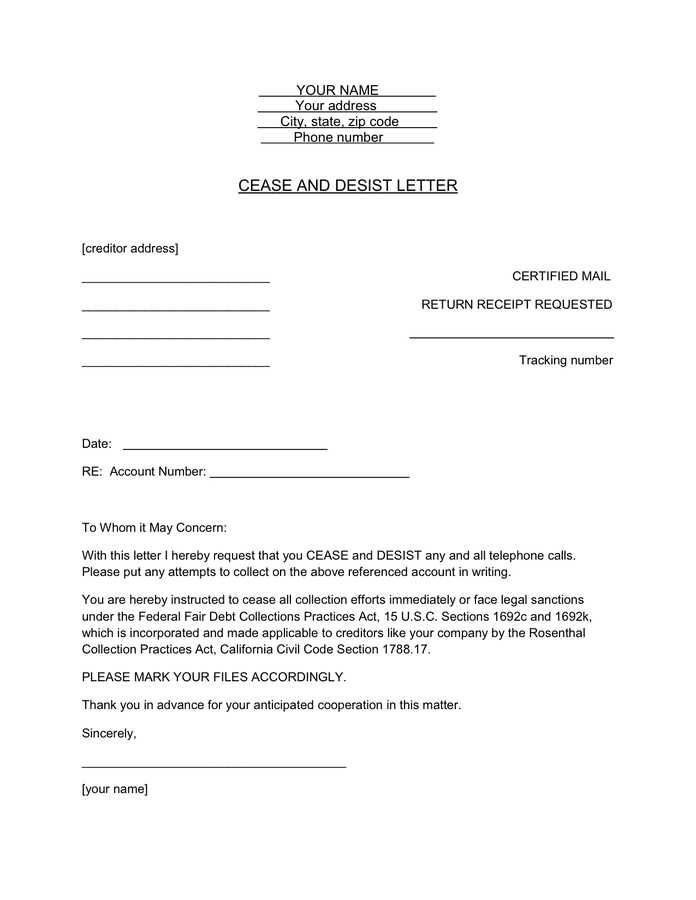Cease and Desist Creditor Letter Template Guide

When dealing with aggressive collection practices, it’s important to know your rights and take action to protect yourself. If you are being harassed by debt collectors, a formal written request can be the solution to stop further contact. This document serves as a tool to assert your rights, informing collectors to cease any unwanted actions or communications. Understanding how to create this request properly can save you from ongoing stress and legal complications.
Why Use a Formal Request?
Sending a well-crafted formal notice helps establish clear boundaries between you and the debt collectors. By sending this communication, you can demand that they stop contacting you, giving you peace of mind. Additionally, it ensures you have documented proof of your request should the situation escalate or legal action be needed later.
When to Take Action
If you feel the communication from collection agencies is excessive, harassing, or violates the law, it’s time to consider sending a formal notice. Common scenarios include repeated phone calls, threats, or unfair tactics to pressure you into paying debts. This type of action can be taken at any point in the collection process, even before court proceedings begin.
Key Components of the Request

A properly written document should be clear, concise, and cover all necessary points. Here are the essential elements:
- Your Identification: Include your full name, address, and contact information to ensure clarity.
- Collector’s Details: Specify the name of the debt collection agency and any reference numbers for the debt in question.
- Statement of Request: Clearly demand that the collector cease all communication with you. Include the legal reason, such as harassment or violation of fair debt collection practices.
- Consequences: Indicate that failure to comply with your request may lead to legal action.
How to Write the Notice

To begin drafting the request, it is essential to remain professional and direct. Avoid emotional language or unnecessary details. Be factual and focus solely on the actions you want to stop. Use clear language and be sure to include any relevant references to laws that support your claim, such as the Fair Debt Collection Practices Act (FDCPA) in the United States. This makes your document more authoritative and can increase its effectiveness.
Legal Considerations

While sending such a request is within your rights, it’s important to understand the potential legal implications. By sending this formal communication, you are legally requesting a halt to further actions, which the collector must honor under most circumstances. However, there are exceptions, and the collector may still pursue other legal means of debt recovery, such as filing a lawsuit. Be aware of your rights and consult legal help if you have concerns.
What Happens After Sending?
Once the request is sent, the collection agency is legally obligated to stop contacting you, unless they have valid legal grounds to continue pursuing the debt. However, it’s important to keep records of all communication for future reference. If the agency violates your request, you may be entitled to file a complaint with the appropriate regulatory authority or even take legal action.
Understanding the Formal Request to Stop Collection Actions
This section explains the purpose and importance of a formal written request designed to halt unwanted collection practices. This official document serves as a means to assert your rights and protect yourself from harassment by organizations pursuing debt recovery. Knowing how and when to use such a request can provide relief and help avoid further complications.
When to Send a Formal Request
If you feel that the collection agency is using inappropriate methods to pursue the debt, it’s essential to take immediate action. This could include frequent calls, threats, or other forms of intimidation. Sending a formal notice should be done when the behavior becomes too aggressive or violates any applicable laws, such as those surrounding unfair debt collection practices.
Key Components of the Formal Request
For your request to be effective, it must be clear, precise, and contain all necessary details. Include your full name, address, and any case or reference numbers for the debt. The document should clearly express your demand for the cessation of communication, referencing any applicable laws that support your position, such as the Fair Debt Collection Practices Act in the U.S.
How to Draft the Request
Crafting a successful document requires being straightforward and to the point. Avoid overly emotional language, and focus on the facts. Mention any legal provisions that protect your rights and clearly state the actions you want the collector to stop. Being concise and professional increases the likelihood of the request being respected.
Legal Factors to Consider Before Sending
Before sending the formal request, ensure that you understand your legal rights. While sending such a document is generally within your rights, collectors may still take legal action if they believe they are entitled to pursue the debt. Consulting with a legal expert can help clarify whether sending the notice is the best course of action for your specific situation.
What Happens After Sending the Formal Request
Once the request is sent, the collector must stop contacting you, with limited exceptions. They may still pursue the debt through other legal channels, such as filing a lawsuit. Keep a record of all communications to ensure that the collector complies with your request, and if violations occur, consider taking further legal action.